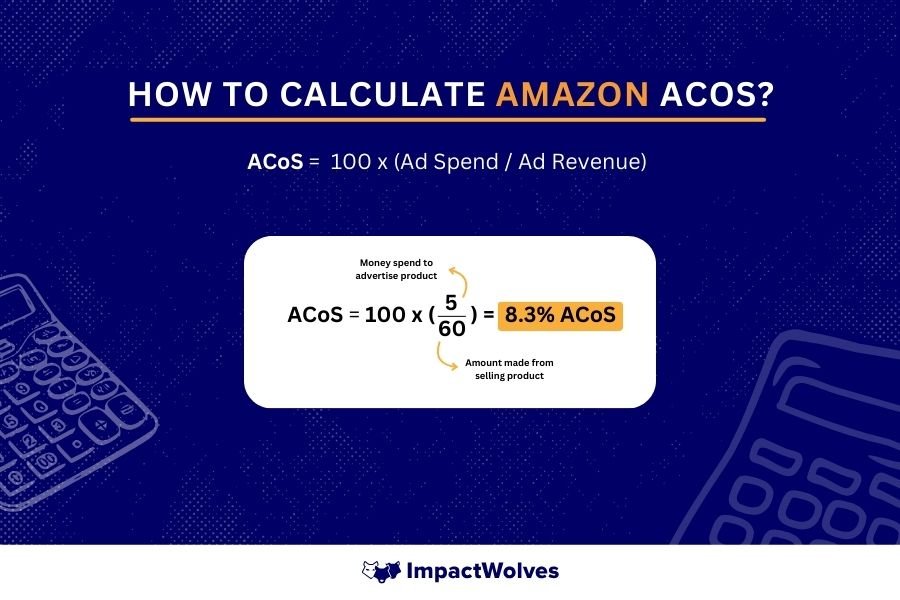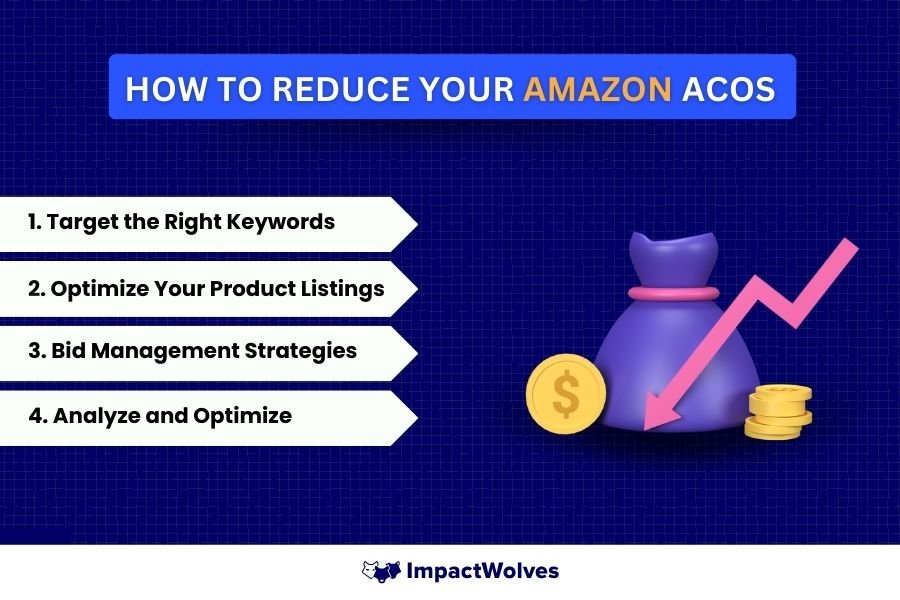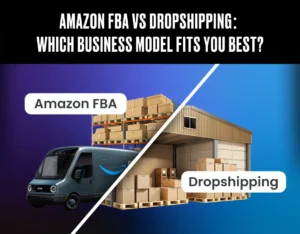Amazon advertising has grown significantly, 5 times since 2018, reaching over a $40 billion annual run rate! This growth shows that many Amazon sellers are now using ads to boost their business.
However, ads cost money, and if you spend too much, it can reduce your profits. That’s why it’s important to keep an eye on your ad spending through a metric called ACoS (Advertising Cost of Sales).
ACoS tells you how much you’re spending on ads compared to what you earn from them.
In this guide, we will tell you all you need to know about ACoS Amazon, how to calculate it, and how to keep it to a minimum.
What is ACoS?
ACoS is the ratio of your ad spend to the revenue generated from those ads.
Why is it important?
It helps you understand if your ads are profitable.
- A lower ACoS means you’re getting a good return on your ad spend.
- While a higher ACoS could indicate that your ads are too expensive
How to track it?
Use Amazon’s ad dashboard and regularly review the advertising reports to monitor your ACoS and make informed decisions about your ad strategy.
And if you’re checking how your ads are doing, you might also want to see how your storefront looks to potential buyers, There’s a helpful guide on how others can find your Amazon storefront easily.
Part 1- What is Amazon ACoS?
ACoS stands for Advertising Cost of Sale. It’s a key metric used to measure the efficiency of your paid advertising campaigns, particularly on Amazon.
Here’s how it works:
- ACoS is calculated by dividing your total ad spend by your total sales generated from those ads, then multiplying by 100.
For example, if you spent $50 on ads and earned $100 in sales, your ACoS would be 50%.
- A lower ACoS is generally considered better, as it means you’re spending less money on advertising to generate the same amount of sales. However, the ideal ACoS can vary depending on factors like your product costs, ad goals, and budget.
- ACoS helps you track the performance of your ad campaigns and identify areas for improvement. For example, if your ACoS is higher than your target, you might need to adjust your Amazon PPC strategy. This includes bids, keywords, or landing pages.
Along with ACoS, many sellers also track TACoS (Total Advertising Cost of Sales), which compares ad spend to total sales, including organic revenue. There’s a simple guide that breaks down how TACoS works and why it matters.
Why is ACoS Important?
ACoS (Advertising Cost of Sales) is a crucial metric for Amazon sellers because it helps determine the profitability of your advertising campaigns and informs strategic decisions about allocating your budget and improving ad performance.
Essentially, ACoS tells you how much you’re spending on ads to get a dollar in sales. It’s like checking if your advertising is working as hard as it should.
Here’s why ACoS is important:
1. Profitability Assessment:
ACoS acts like a simple profit check. It directly measures the ratio of your advertising spend to the sales revenue your ads generate. This means you can quickly see if your campaigns are actually making you money, or if they’re costing you more than they’re bringing in. If your ACoS is too high, it’s a red flag that you’re spending too much for the sales you’re getting.
2. Campaign Optimization:
Think of ACoS as a tool to fine-tune your advertising. By tracking ACoS, you can see which campaigns, products, and keywords are performing best. This lets you focus on what’s working and change what’s not, maximizing your returns. You can quickly identify what is working, and what is not.
3. Budget Allocation:
You have a limited advertising budget, and ACoS helps you use it effectively. It shows you which campaigns are delivering the best results, so you can invest more in them. On the other hand, it also highlights campaigns that are underperforming, allowing you to cut back and save money.
When managing your ad budget, it’s also useful to understand what Amazon ads cost, There’s a straightforward guide that breaks down the pricing in simple terms.
4. Break-Even and Target ACoS:
Every business has a point where it breaks even, where its costs equal its revenue. ACoS helps you figure out your break-even ACoS for advertising. Knowing this, you can set a target ACoS, which is the level you want to achieve to make a profit. This helps you manage your advertising budget and set realistic goals.
5. Improve Efficiency:
A lower ACoS means your advertising is more efficient. You’re getting more sales for every dollar you spend. By consistently monitoring and optimizing your ACoS, you can make your campaigns more efficient and improve your overall return on investment.
6. Campaign Level Importance:
It’s important to keep in mind that ACoS is very important at the campaign level. Different campaigns will have different goals, and therefore different target ACoS numbers. For example, a campaign to launch a new product might have a higher target ACoS than a campaign for a well established product.
In essence, ACoS is your guide to making sure your Amazon ads are profitable and efficient. It helps you make smart decisions about your advertising budget and helps you improve the performance of your ad campaigns.
Part 2- How to Calculate Amazon ACoS?

ACoS (Advertising Cost of Sales) is a key metric for Amazon sellers to understand the efficiency of their advertising. It tells you what percentage of your ad spend is being used to generate sales.
Here’s how to calculate it:
1. Understand the Formula:
ACoS = (Ad Spend / Ad Revenue) x 100
2. Gather Your Data:
Ad Spend: This is the total amount of money you’ve spent on your Amazon advertising campaigns.
Ad Revenue: This is the total sales revenue generated directly from your Amazon ads.
3. Apply the Formula:
Divide your total ad spend by your total ad revenue.
Multiply the result by 100 to get a percentage.
Example:
Let’s say you spent $100 on Amazon ads and generated $500 in sales.
ACoS = ($100 / $500) x 100
ACoS = 0.2 x 100
ACoS = 20%
This means that 20% of your ad revenue was spent on advertising.
4. Interpretation:
A lower ACoS is generally better. It means you’re spending less on advertising to generate the same sales.
In the example above, a 20% ACoS means that for every 100 in sales,20 was spent on advertising.
Key Takeaways:
- ACoS is expressed as a percentage.
- It helps you assess the profitability of your Amazon advertising campaigns.
- Industry, product type, and campaign strategy can influence your ACoS.
Important Note:
- After calculating your ACoS, the next important question is, “Is this a good ACoS?” This will depend on your specific business goals and profit margins.
Part 3- What is a Good ACoS Amazon and How to Choose Your Target ACoS?
A good ACoS depends on your product’s profit margin and overall business goals. Essentially, your target ACoS should allow you to spend on ads while still making a profit.
Here’s how to choose your target ACoS:
1. Understand Profit Margins
If your profit margin is high, you can afford a higher ACoS. For products with lower profit margins, a lower ACoS is needed to avoid losing money.
2. Look at Industry Benchmarks
Many sellers aim for an ACoS between 15% and 30%, but this can vary. It’s important to compare with similar products in your niche.
3. Consider Business Goals
- Growth: If you’re focusing on increasing market share or boosting product visibility, you might accept a higher ACoS temporarily.
- Profitability: If your goal is to maximize profits, aim for a lower ACoS to ensure ad spend is efficiently driving sales.
4. Calculate Your Target ACoS
Use your profit margin as a guide. For example, if your profit margin is 40%, setting a target ACoS around 25% can provide a healthy buffer.
Here’s how to calculate your target ACos:
Target ACoS = (Advertising Spend ÷ Revenue) × 100
5. Experiment and Adjust
Regularly review your performance. Start with a target based on your margins and adjust based on real-world results and changing market conditions.
By understanding your costs and business goals, you can choose a target ACoS that helps you grow your sales while keeping your profits intact.
What Factors Influence ACoS on Amazon?
Once you understand what ACoS is, you might wonder: what affects it, and how can I achieve a favorable ACoS in my advertising?
Several essential parameters significantly influence ACoS. This includes:
- Cost-Per-Click (CPC): Lower CPCs naturally contribute to a more favorable ACoS.
- Conversion Rate: Efficiently converting clicks into sales directly skyrockets your ACoS.
- Product Sale Price: Products with higher price points offer more room for ad spend within a target ACoS range.
Also, choosing reliable inventory, such as items sold and shipped directly by Amazon, can impact customer trust and improve conversion rates, which may help lower your ACoS.
So, getting the best ACoS is about balancing these things well. Like, products that cost more might have a good ACoS, but if not many people buy them, that can be tricky.
Part 4- What is Break-Even ACoS & How to Find It?
Break-even ACoS is the advertising cost percentage at which your ad spend exactly matches your profit margin, meaning you’re not making a profit, but you’re not losing money either. It’s a useful metric to understand how much you can spend on ads before cutting into your profits.
How to Find Your Break-Even ACoS
Step 1: Know Your Profit Margin
Calculate your profit margin by subtracting your costs (including production, shipping, etc.) from your selling price, then dividing by the selling price.
Profit Margin (%) = [(Selling Price – Cost) ÷ Selling Price] × 100
For example, if you sell a product for $100 and your profit is $30, your profit margin is 30%.
Step 2: Set Your Break-Even ACoS
Your break-even ACoS is the percentage of your profit margin. In the example above, a 30% ACoS would be your break-even point.
Step 3: Use the Formula
The basic formula is:
Break-even ACoS = (Advertising Spend ÷ Revenue) × 100
At break-even, this percentage should equal your profit margin.
By knowing your break-even ACoS, you can better manage your ad campaigns.
- If your ACoS is below the break-even point, you’re making a profit on your ads.
- If it’s above, you’re spending more on ads than you earn in profit.
Which brings us to…
Since shipping costs also affect your overall profit margin, it’s worth knowing how services like USPS handle weekend deliveries, especially if you’re factoring in fulfillment timelines.
Part 5- How to Reduce Your Amazon ACoS

Reducing ACoS involves Amazon PPC optimization to improve efficiency and increase profitability.
Here are some strategies to help you with it:
1. Target the Right Keywords
- Ditch the broad search terms and focus on keywords with clear buyer intent.
- Block irrelevant searches that waste your ad spend.
- Lower competition and higher conversion rates can lead to a lower ACoS.
2. Optimize Your Product Listings
- Clearly communicate product value and benefits to entice clicks.
- Showcase your product in its best light to boost conversions.
- Build trust and credibility to inspire purchases.
3. Bid Management Strategies
- Automatically adjust bids to only increase when likely to win an ad auction.
- Fine-tune bids for specific keywords based on their performance and ACoS impact.
- Allocate your budget effectively across campaigns based on ACoS and sales goals.
4. Analyze and Optimize
- Identify areas for improvement and adjust your strategy accordingly.
- Discover the most cost-effective way to reach your target audience.
- Ensure a seamless buying experience from click to conversion.
Part 6 – How to Diagnose Amazon ACoS Spikes?
When you notice a sudden spike in your Amazon ACoS, start by checking these key areas:
1. Review Campaign Metrics
Check for changes in impressions, clicks, and conversions to see if performance has dropped unexpectedly.
2. Analyze Keyword Performance
Find keywords that cost more but get fewer conversions. Check for increased bid amounts or changes in search trends.
3. Evaluate Ad Placement & Settings
Check if automatic placements or recent changes, like bid adjustments or new targeting options, are impacting performance.
4. Check Product Listings
Keep product details, images, and pricing competitive. Problems in these areas can lower conversion rates and increase your ACoS.
5. Consider Seasonal & Competitive Factors
Check external factors like seasonal changes in demand or more competition that might be increasing ad costs.
Keeping an eye on ACoS spikes and reducing it is a continuous process. Implement these strategies, monitor your results, and optimize your approach to conquer the Amazon advertising landscape!
However, managing your Amazon advertising and business transitions, like changing ownership of an Amazon seller account, might seem like a hassle for most entrepreneurs.
So, why not…
Partner With an Amazon PPC Agency
If you think that reducing your ACoS Amazon and handling that comes with it is too much to handle, let Impact Wolves take the loaf off your shoulders!
Impact Wolves is an Amazon advertising agency that specializes in Amazon PPC management and offers a range of services, including:
- Campaign Strategy & Setup
We provide expert help to set up your account, create customized campaigns, and plan strategies that match your business goals.
- Amazon PPC Optimization
Our Amazon PPC experts offer ongoing management of bids, optimize keywords, and research negative keywords to make sure spending is efficient.
- Performance Monitoring & Reporting
Impact Wolves provides detailed analytics and regular reports to help you understand and improve your ad performance.
- Competitor Analysis
It provides detailed market research and competitor insights, like how to search for a seller on Amazon, to help you stay ahead in your field.
Are you ready to lower your ACoS and increase your profits? Schedule a free consultation with our Amazon PPC expert to improve your Amazon PPC strategy!
Conclusion
To sum it up, ACoS Amazon shows you how much you spend on ads compared to what you earn in sales. By keeping an eye on your ACoS, you can quickly spot any issues and make the changes needed to keep your advertising profitable. Regularly tracking your ACoS and diagnosing any spikes helps you understand what works and what doesn’t so you can adjust your strategy and grow your business.
And, if you ever need expert advice or help with optimizing your campaigns, consider partnering with a trusted Amazon PPC agency like Impact Wolves to get the most out of your Amazon PPC efforts!
FAQs
What is Amazon ACoS, and how is it calculated?
ACoS Amazon is the comparison of how much you spend on ads to the money you make from them, usually shown as a percentage.
You can calculate it using the formula:
ACoS = (Total Ad Spend ÷ Total Ad Revenue) × 100
Why is tracking ACoS important for my Amazon business?
Keeping an eye on your ACoS is a great way to see if your ad spending is working for you. It helps ensure you’re not spending too much on ads compared to how much you’re making.
What are common reasons for ACoS spikes?
Spikes can happen for various reasons, like:
- Shifts in how keywords perform
- Adjustments in your ad settings
- Changes with the seasons
- More competitors jumping in
How can I reduce my Amazon ACoS?
To improve your results, start by:
- Optimizing your keywords
- Adjust your bids
- Enhance your product listings
Consider using professional PPC management services





